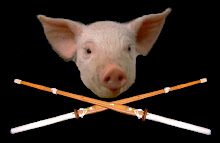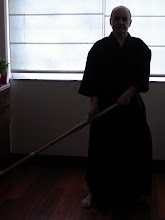In General, samurai society was dominated by men, but history records that the female members of the samurai clans often displayed a fighting spirit and a concern for honour and duty matching that of the men.
Women were trained in the martial arts and, in time, many became highly skilled, especially in the use of naginata.
Tales of courageous and devoted samurai women abound in the epic “Heike Monogatari”. A chief among these women was Minamoto Yoshinaka’s wife, Tomoe Gozen, but the period produced numerous other heroic samurai women, including Hojo Masako, the wife of Minamoto Yoritomo, who was known as “the general in nun’s habit” (on her husbands death, she became a Buddhist nun, the traditional fate of samurai widows). Masako was a prominent political player in the early years of the Hojo regency that succeeded her husband, at one point engaging in open conflict with her father. From her new position as a Buddhist nun, she successfully bullied the samurai class into standing by the shogunate.
These stories reflect the relatively strong position women held in samurai society at the time. Laws governing the shogun’s court in the early 13th century allowed women equal rights of inheritance with brothers and the right to bequeath property. Samurai and bushi wives had high status in the household. They controlled household expenditure, managed servants, and were called upon to defend the home in times of war. They were also responsible for raising their children to the samurai ideas of contempt, death and unquestioning loyalty to their lord.
 Over the centuries that followed, the practice of using daughters as pawns in the marriage market (a crucial tool in the struggles of the period) and the influence of neo-confucain philosophy, combined to reduce the status of female samurai. The ideal of fealess devotion was gradually replaced by one of quiet passive obedience, a change reflected by the introduction of the new words for wife: Kani and okusan (person in the innermost recesse of the house).
Over the centuries that followed, the practice of using daughters as pawns in the marriage market (a crucial tool in the struggles of the period) and the influence of neo-confucain philosophy, combined to reduce the status of female samurai. The ideal of fealess devotion was gradually replaced by one of quiet passive obedience, a change reflected by the introduction of the new words for wife: Kani and okusan (person in the innermost recesse of the house).

One women, Nakano Takeko, was highly skilled in the use of the naginata, and during the fighting she rushed into enemy lines and cut down many men. Eventually she was shot in the chest. To aviod the disgrace of capture, she told her sister Yuko to remove her head and take it home.
A monument to her was erected in the Hokai temple in Aizu Bangemachi, Fukishima province.
Women were trained in the martial arts and, in time, many became highly skilled, especially in the use of naginata.
Tales of courageous and devoted samurai women abound in the epic “Heike Monogatari”. A chief among these women was Minamoto Yoshinaka’s wife, Tomoe Gozen, but the period produced numerous other heroic samurai women, including Hojo Masako, the wife of Minamoto Yoritomo, who was known as “the general in nun’s habit” (on her husbands death, she became a Buddhist nun, the traditional fate of samurai widows). Masako was a prominent political player in the early years of the Hojo regency that succeeded her husband, at one point engaging in open conflict with her father. From her new position as a Buddhist nun, she successfully bullied the samurai class into standing by the shogunate.
These stories reflect the relatively strong position women held in samurai society at the time. Laws governing the shogun’s court in the early 13th century allowed women equal rights of inheritance with brothers and the right to bequeath property. Samurai and bushi wives had high status in the household. They controlled household expenditure, managed servants, and were called upon to defend the home in times of war. They were also responsible for raising their children to the samurai ideas of contempt, death and unquestioning loyalty to their lord.
“A creature of… no importance”
 Over the centuries that followed, the practice of using daughters as pawns in the marriage market (a crucial tool in the struggles of the period) and the influence of neo-confucain philosophy, combined to reduce the status of female samurai. The ideal of fealess devotion was gradually replaced by one of quiet passive obedience, a change reflected by the introduction of the new words for wife: Kani and okusan (person in the innermost recesse of the house).
Over the centuries that followed, the practice of using daughters as pawns in the marriage market (a crucial tool in the struggles of the period) and the influence of neo-confucain philosophy, combined to reduce the status of female samurai. The ideal of fealess devotion was gradually replaced by one of quiet passive obedience, a change reflected by the introduction of the new words for wife: Kani and okusan (person in the innermost recesse of the house).
By the 17th century, many samurai felt that while women were necessary to bear children, they were not really fitting companions for warriors. A cult of homesexuality developed amoung some warriors and, despite repeated prohibiton, many adult samurai formed close relationships with men. In 1687, Ihara Saikaku published his famouse book “Nanshoku okagami” (“The Great Mirror of Manly Love”), which took the homosexual activities amoung the samurai as its theme. “Woman is a creature of absolutely no importance’, he wrote, “but sincere pederastic love is true love”.
Samurai women were still expected to show contempt for death when it came to defending their husbands honour. A wife’s sacrifice of herself, or her honour, for the sake of her husband was a common theme in Japanese drama. Self-renunciation was an imperative for women and remained so even at the end of the 19th century, despite the popularity of western ideas.
Samurai women were still expected to show contempt for death when it came to defending their husbands honour. A wife’s sacrifice of herself, or her honour, for the sake of her husband was a common theme in Japanese drama. Self-renunciation was an imperative for women and remained so even at the end of the 19th century, despite the popularity of western ideas.
Inanzo Nitobe, writing in 1905, devoted one chapter of his book “Bushido: The soul of Japan”
to “The Training and position of women”. This underlines the inferior role accorded to women, telling us that: “In the ascending scale of service stood woman, who annihilated herself for a man, that he might annihilate himself for the master, that he in turn might obey Heaven’.
However, the fighting sprit of the female samurai still managed to show itself on occasion. Their martial prowess was demonstrated during the Satsuma Rebellion of 1877, when the women of Kagoshima fought against the imperial army. In 1868, the fighting between suporters of the shogunate and those supporting the imperial restoration provided another such display.
to “The Training and position of women”. This underlines the inferior role accorded to women, telling us that: “In the ascending scale of service stood woman, who annihilated herself for a man, that he might annihilate himself for the master, that he in turn might obey Heaven’.
However, the fighting sprit of the female samurai still managed to show itself on occasion. Their martial prowess was demonstrated during the Satsuma Rebellion of 1877, when the women of Kagoshima fought against the imperial army. In 1868, the fighting between suporters of the shogunate and those supporting the imperial restoration provided another such display.
Samurai of the Aizu clan, supporters of the shogunate, were left to defend their stronghold of wakamatsu Castle without any hope of outside assistance. Heaviley out-numbered by an army of 20,000 men, the 3,000 Aizu samurai mobilized anyone who could use a weapon. A group of 20 women formed a unit that fought on the front line.

One women, Nakano Takeko, was highly skilled in the use of the naginata, and during the fighting she rushed into enemy lines and cut down many men. Eventually she was shot in the chest. To aviod the disgrace of capture, she told her sister Yuko to remove her head and take it home.
A monument to her was erected in the Hokai temple in Aizu Bangemachi, Fukishima province.
Taken from: Japanese weapons






No hay comentarios:
Publicar un comentario